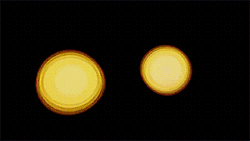Hold Your Nose At This Science Pun.

Hold your nose at this science pun.
More Posts from Drunkscience4u and Others
Please subscribe, like, comment, and donate! Stay tuned for Bloopers from this episode on April 22, 2017. This was the last episode of this season. Keep an eye out on the facebook page for more information on Season 2. Please comment below for any experiments or simple science you'd like us to explain while drunk! Starring: Candice Lola Directed by Rebecca Berger Produced by Rebecca Berger and Candice Lola Written by Candice Lola Editing, Color, Sound Design by Rebecca Berger Animation by Rachael K McDonald Links: Music: http://ift.tt/1JICaNj and http://ift.tt/2lquxdO http://ift.tt/2lINlQJ http://ift.tt/2lqtjzr http://ift.tt/2lIL08B http://ift.tt/2lqvuCQ (Donations are always welcome!) http://ift.tt/2lITyw7 http://ift.tt/2lqvQJO









Black Hole Caught Devouring Star For An Entire Decade
“Normally lasting weeks or months, a new record has just been set for TDEs. XJ1500+0154, 1.8 billion light years away, is the largest, longest-lasting one ever seen. First detected in July of 2005, the X-rays from this distant source brightened by a factor of 100 over 3 years. They remain bright even today. Although dozens of TDEs have been observed since the 1990s, none have lasted this long. It may be caused by the most massive star ever observed creating a TDE.”
When any object passes too close to the event horizon of a black hole, the tidal forces acting on it can become so strong that they’ll tear the entire object apart in a spaghettification disaster. While most of the matter will get ejected from the encounter, a significant fraction can be accreted, absorbed and used to fuel the black hole’s growth. These tidal disruption events have been seen numerous times since the launch of our X-ray observatories, and are now known to come in a wide variety of magnitudes, at a variety of distances and to last a variable amount of time. So when you see the largest, longest-lasting one ever, you sit up and take notice! That’s exactly what’s happened with XJ1500+154, which is now in its second decade of X-ray signals.
Come get the full story on this amazing object, and learn how it might solve the puzzle of supermassive black hole growth on today’s Mostly Mute Monday!

Go. Get. COVERED! Enrollment started yesterday and ends December 15! Don’t forget!! Please ignore the following hashtags. They are for the sole purpose of spreading this reminder further. #funny #friends #healthylifestyle #congratulations #halloween #naturalhair #makeup #me #meme #memes http://ift.tt/2iTXazP

Primitive plants are the latest forms of Earth life to show they can survive in the harshness of space, and for many months. Cold-loving algae from the Arctic Circle have joined the space-travelling club, alongside bacteria, lichens and even simple animals called tardigrades.
Preliminary studies of the algae after their return to Earth from the International Space Station lend some weight to the “panspermia” theory, that comets and meteorites could potentially deliver life to otherwise sterile planets. The results also provide insights into the potential for human colonies on distant planets to grow crops brought from Earth.
The algae were of the Sphaerocystis species, codenamed CCCryo 101-99, and were returned to Earth in June last year after spending 530 days on a panel outside the ISS. While space-borne, they withstood the vacuum, temperatures ranging from -20 °C at night to 47.2 °C during the day, plus perpetual ultraviolet radiation of a strength that would destroy most life on Earth if not filtered out by the atmosphere.
“I’m sure that plants of many kinds have been on the ISS before, but on the inside, not the outside,” says Thomas Leya of the Fraunhofer Institute for Cell Therapy and Immunology in Potsdam, Germany, who organised the algae experiment. “As far as I know, this is the first report of plants exposed on the surface of the space station.”
Continue Reading.

Mole-cool


A star created 1,800 years ago after the collision of two distant suns is set to appear in the night sky for the first time – as the light from the crash finally reaches the Earth.
Scientists predict that for six months in 2022, stargazers will be able to witness the birth of the new star, by fixing their telescopes near the Pisces and Cygnus constellations. Dubbed the Boom Star, it has taken nearly two millennia for its light to reach earth — where it will be able to be seen by the naked eye. Astronomers expect the collision to increase the brightness of the pair ten thousand fold, making it one of the brightest stars in the heaven for a time. The explosion, known as a Red Nova, will then dissipate and the star will remain visible in our skies as a single bright, but duller, dot.
Your not going to want to miss this appear in our sky as it’s a once in a lifetime event! Source

There will be drink. There will be science. There will be funny.
New Youtube series my friend and I are putting together. Come follow the facebook and youtube for more information!!!



Time for another comic on our reddish dwarf planet, Makemake!
(Polaris is pushed for tomorrow ;) )
http://www.space.com/23122-makemake.html







This Black History Month, let’s celebrate the first African-American woman who traveled in space.

Let’s celebrate black people, who made history! This is so important to know that some of us didn’t give up and were strong enough to achieve something great like this. These stories are inspirational , but we don’t see them in our history books. Even though she was told women can’t go into space, she never stopped believing in her dreams.
“As a little girl, I was excited, and people kept trying to explain to me why women couldn’t go into space,” Jemison said, according to the university’s student newspaper, The Plainsman. “I always thought they were full of it.”
She’s the role model for every black kid, who has big dreams! She is a living proof everything’s possible!
#BlackHistoryMonth
-
 alriiiiiight liked this · 1 year ago
alriiiiiight liked this · 1 year ago -
 hobbitatbakerstreet liked this · 4 years ago
hobbitatbakerstreet liked this · 4 years ago -
 megrimwolds reblogged this · 5 years ago
megrimwolds reblogged this · 5 years ago -
 emilyarmadillo liked this · 5 years ago
emilyarmadillo liked this · 5 years ago -
 birchbbier liked this · 5 years ago
birchbbier liked this · 5 years ago -
 mysticbagelflaphands-blog liked this · 5 years ago
mysticbagelflaphands-blog liked this · 5 years ago -
 brightfern liked this · 5 years ago
brightfern liked this · 5 years ago -
 neku-phones-sakuraba reblogged this · 6 years ago
neku-phones-sakuraba reblogged this · 6 years ago -
 neku-phones-sakuraba liked this · 6 years ago
neku-phones-sakuraba liked this · 6 years ago -
 gracie1007 liked this · 6 years ago
gracie1007 liked this · 6 years ago -
 nospheratusblack liked this · 6 years ago
nospheratusblack liked this · 6 years ago -
 saltybiologykid-blog liked this · 6 years ago
saltybiologykid-blog liked this · 6 years ago -
 old-unused-account liked this · 6 years ago
old-unused-account liked this · 6 years ago -
 yikeswithacapitoly liked this · 6 years ago
yikeswithacapitoly liked this · 6 years ago -
 starlight-sparks liked this · 6 years ago
starlight-sparks liked this · 6 years ago -
 daedricprincessorigin liked this · 6 years ago
daedricprincessorigin liked this · 6 years ago -
 existential-crisis-territory liked this · 6 years ago
existential-crisis-territory liked this · 6 years ago -
 savingthime reblogged this · 6 years ago
savingthime reblogged this · 6 years ago -
 being-gay-ft-sarcasm reblogged this · 6 years ago
being-gay-ft-sarcasm reblogged this · 6 years ago -
 prince-of-a-thousand-enemies liked this · 6 years ago
prince-of-a-thousand-enemies liked this · 6 years ago -
 recklessandwitchy-blog liked this · 6 years ago
recklessandwitchy-blog liked this · 6 years ago -
 dread-cypress reblogged this · 6 years ago
dread-cypress reblogged this · 6 years ago -
 dread-cypress liked this · 6 years ago
dread-cypress liked this · 6 years ago -
 nagati liked this · 6 years ago
nagati liked this · 6 years ago -
 maabeuling-nim liked this · 6 years ago
maabeuling-nim liked this · 6 years ago -
 rye28 liked this · 6 years ago
rye28 liked this · 6 years ago -
 owl-of-athena liked this · 6 years ago
owl-of-athena liked this · 6 years ago -
 mychemicalnations liked this · 6 years ago
mychemicalnations liked this · 6 years ago -
 destiny14444 liked this · 6 years ago
destiny14444 liked this · 6 years ago -
 mystikk-spir4l liked this · 6 years ago
mystikk-spir4l liked this · 6 years ago -
 kittkatz liked this · 6 years ago
kittkatz liked this · 6 years ago -
 arya-dorringdu-blog liked this · 6 years ago
arya-dorringdu-blog liked this · 6 years ago -
 rockangel72701 reblogged this · 6 years ago
rockangel72701 reblogged this · 6 years ago -
 rockangel72701 liked this · 6 years ago
rockangel72701 liked this · 6 years ago -
 felinelover-blog1 liked this · 6 years ago
felinelover-blog1 liked this · 6 years ago -
 artificiallyreal liked this · 6 years ago
artificiallyreal liked this · 6 years ago -
 omg-easter-is-coming liked this · 6 years ago
omg-easter-is-coming liked this · 6 years ago -
 theyankeeravenclaw reblogged this · 6 years ago
theyankeeravenclaw reblogged this · 6 years ago -
 theyankeeravenclaw liked this · 6 years ago
theyankeeravenclaw liked this · 6 years ago -
 1gayengineer liked this · 6 years ago
1gayengineer liked this · 6 years ago -
 sohamgup-blog liked this · 6 years ago
sohamgup-blog liked this · 6 years ago -
 calciumcow reblogged this · 6 years ago
calciumcow reblogged this · 6 years ago -
 likethegardenofeden liked this · 6 years ago
likethegardenofeden liked this · 6 years ago
The official page of Drunk Science! An enthusiastic host performs simple experiments and then humorously explains the science behind the result, all while visibly drunk.
126 posts